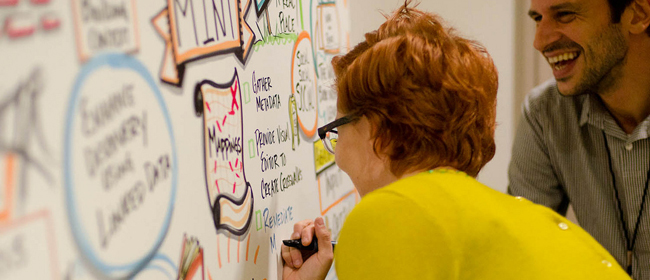Bookworm
The first of the three Beta Sprint Lightning Round presentations at the October 2011 plenary meeting was Bookworm, a project of the Cultural Observatory at Harvard University, with Ben Schmidt and Martin Camacho presenting.
This project explores new methods of browsing OPAC and library holdings search results—the predominant form of browsing search results only allows you to see a handful of search results at the same time, and gives you facets on the side to narrow your search results further. While this is a good system, the Bookworm team asked, “How can we make it so that you can easily browse through large sets of books at the same time—how can we encourage browsing and allow a user to retain the sense of exploring a library?” Bookworm allows users to create data visualizations for large collections of materials by defining the various axes on a graph as search terms over time (or other conditionals), and then to create a set of comparative graphs based on different search terms. For example, a user might create a search to see how often the word “evolution” occurs in publications from the nineteenth century in three different categories, “all books”, “science books” and “social sciences books.” This search would create a set of three different plotted lines, each a different color, to represent the change over time of usage of the word “evolution” within each category. The user can then click on the line for say social sciences at a particular time junction, say 1880, and see a list of all the books published in the social sciences from 1880 that contain the word “evolution.”
DPLA Collection Achievements and Profiles System
The second of the three Lightning Round presentations was the DPLA Collection Achievements and Profiles System, a project from the North Carolina State University Libraries, with Tito Sierra presenting.
Tito suggests that in simplified terms, the goal of this project is to build something like a LinkedIn profile for every special library, archive, and museum collection the country. Rather than building a tool, a destination, or a website, what they propose is a platform that simplifies aggregation of collections and facilitates interoperability between them. While a basic collection profile requires very little information in order to keep the barrier to entry low, this profile is also highly extensible by way of “achievements,” which function something like widgets that can be added to each collection’s profile. This team envisions the DPLA as a networking platform for collections, as opposed to a single aggregated collection or gateway to a federated search.
Wikicite—A Universal Citation Platform
The final Lightning Round presentation was “Wikicite—A Universal Citation Platform”, a Wikimedia community project with Samuel Klein presenting.
Wikicite aims to address the issue of source reliability and authenticity in a born-digital information world by using crowdsourcing and wiki technology to provide a means to discuss citations in context. For example, rather than a Wikipedia citation linking directly to the source in question, the citation would link to its own Wikicite page, which would show the citation in the context of related literature, sources for the original work, and any other relevant discussion or information. Wikicite would also support visualization of citation data, so that users may quickly understand who cites a given source and what things are cited along with it.
The first installment of the Beta Sprint presentations is available here.
The second installment of the Beta Sprint presentations is available here.
